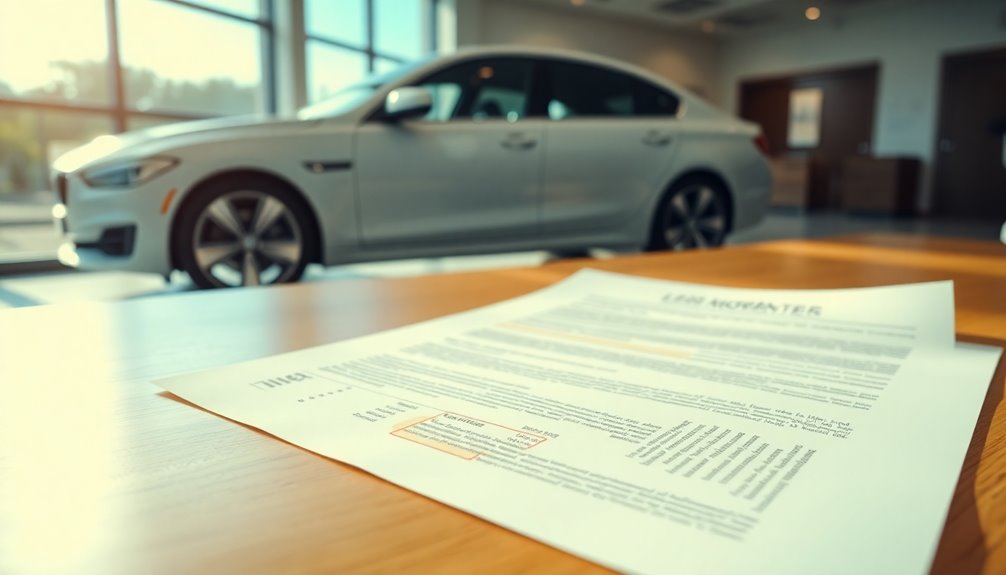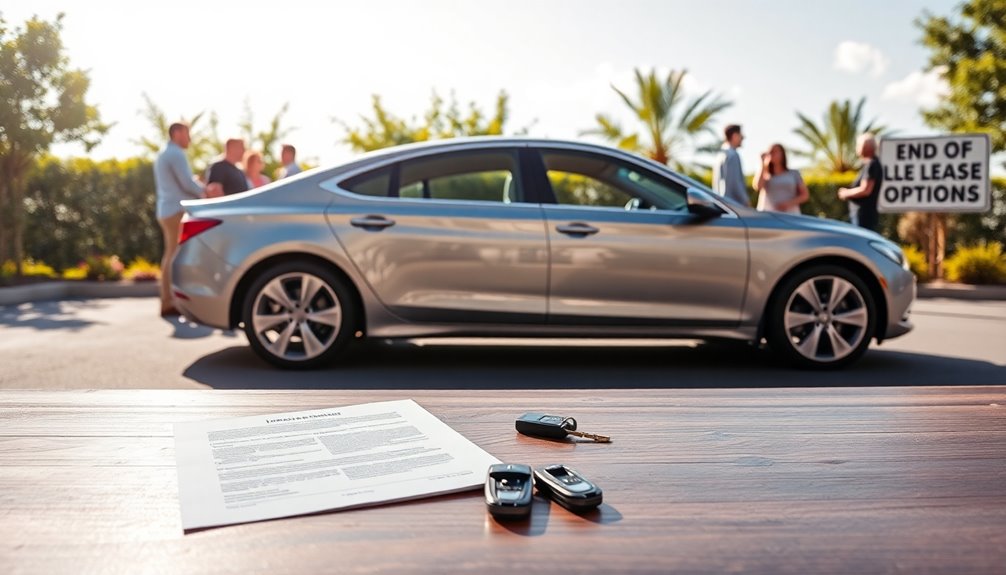Leasing a car means you're renting a vehicle for a set term, usually between 2 to 5 years. You make monthly payments, which mainly cover the car's depreciation, often resulting in lower costs compared to buying. While you get to drive a new model, you don't own the vehicle and won't build any equity. Typically, there are mileage limits, so you'll want to take into account how much you drive. At the end of the lease, you can return the car, buy it, or lease a new one. There's plenty more to explore about the advantages and options available.
Key Takeaways
- Leasing a car involves renting a vehicle for a specified duration, typically 2 to 5 years, with lower monthly payments than buying.
- Lease agreements include terms such as monthly payments, lease duration, and mileage limits, usually ranging from 10,000 to 15,000 miles annually.
- At the end of the lease, options include returning the vehicle, purchasing it, or leasing a new one.
- Leasing does not build equity in the vehicle, as you do not own it at the end of the lease term.
- Understanding lease terms like capitalized cost, residual value, and money factor is crucial for evaluating total leasing costs.
Understanding Car Leasing
Understanding car leasing can be a game-changer for your driving experience. When you enter into a lease agreement, you fundamentally rent a vehicle for a specified duration, usually between 2 to 5 years. Instead of covering the entire purchase price, your monthly payments focus on the vehicle's depreciation, making them generally lower than auto loan payments. This aspect can make leasing particularly appealing if you want to drive a new car without the long-term commitment of ownership.
However, keep in mind that most leases come with mileage limits, typically set between 10,000 to 15,000 miles annually. Exceeding these limits can lead to fees of $0.10 to $0.50 per mile.
At the lease's end, you have several options: return the vehicle, purchase it at a predetermined price, or lease a new one. Good credit is often required for favorable lease terms, as the average credit score for lessees is around 736.
Additionally, many leases include maintenance coverage and factory warranties, minimizing your out-of-pocket repair costs. Overall, understanding these elements can help you make an informed decision about whether leasing is right for you.
Furthermore, it's essential to be aware of lease end options that can influence your final decision.
Key Differences: Leasing vs. Buying

When it comes to deciding between leasing and buying a car, it's essential to grasp the key differences that can greatly impact your finances and lifestyle. One of the most significant distinctions is that leasing typically involves lower monthly payments compared to buying. Lease payments cover depreciation rather than the full purchase price of the vehicle, making it more affordable upfront.
However, with leasing, you don't build equity in the vehicle. Purchasing allows you to own the car outright, giving you the option to sell or trade it later. Additionally, lease agreements often come with mileage restrictions, usually ranging from 10,000 to 15,000 miles per year. In contrast, buying generally permits unlimited mileage without penalties. This makes it important to consider your driving habits, as exceeding the mileage limits can lead to excess wear and tear charges.
At the end of a lease, you can either return the vehicle, purchase it at a predetermined price, or lease a new one. When you buy, ownership is yours once the loan payments are completed. Furthermore, leasing often includes maintenance coverage, which can significantly reduce your out-of-pocket repair expenses. This is particularly beneficial as most leases coincide with the vehicle's warranty period, minimizing unexpected costs during that time.
Financial Considerations of Leasing

Leasing a car can be an enticing option for those looking to drive a new vehicle without the hefty price tag of ownership. One of the main financial considerations is that lease payments are typically lower than monthly payments on a financed car since they're based on the vehicle's depreciation rather than its full purchase price.
If your average credit score falls between 680-739, you might secure better lease terms and lower down payments.
However, keep in mind that leasing means you have no ownership, so you won't build equity in the vehicle. At the end of the lease, you could face additional costs such as excess mileage fees or wear and tear charges if the vehicle isn't returned in good condition.
Additionally, be cautious about potential early termination fees, which can be significant if you need to end your lease before the agreed term.
While leasing can offer attractive leasing incentives, it may end up more expensive in the long run. Always weigh the benefits against these financial considerations to guarantee leasing fits your budget and driving habits.
Important Lease Terms Explained

While maneuvering through the world of car leasing, it's vital to familiarize yourself with key lease terms that can greatly impact your financial commitment.
First, the Capitalized Cost represents the total amount you're financing in the lease, which includes the vehicle price, taxes, and fees. This figure directly influences your monthly lease payments.
Next, consider the Residual Value. This is the predetermined value of the vehicle at the end of your lease term, playing an important role in calculating depreciation. You're fundamentally paying for the vehicle's depreciation instead of its full value.
The Money Factor functions like an interest rate, determining your rent charge on the lease. Negotiating this can lower your overall costs.
Additionally, keep an eye on the Disposition Fee, a charge for preparing the vehicle for resale at the lease's end, often outlined in the lease contract. If you're considering a lease buyout, you'll want to understand how these terms affect your total costs.
End of Lease Options

As your lease term comes to a close, you've got several options to contemplate for handling your vehicle.
When your lease ends, you can choose to return the car, purchase the vehicle at its predetermined residual value, or lease new. If you decide to return the car, be prepared for an inspection that checks for excessive wear and tear, as well as mileage overages.
Exceeding the mileage limit, usually set at 10,000 to 15,000 miles annually, may lead to additional fees.
If you're interested in keeping the vehicle, the option to buy allows you to purchase it at its value at the end of the lease. This can be a great choice if you've taken good care of it and it suits your needs.
Alternatively, you can simply walk away by returning the car and settling any outstanding fees, including a potential disposition fee for preparing the vehicle for resale.
Ultimately, consider your financial situation and preferences when evaluating these end-of-lease options, ensuring that you make the best choice for your circumstances.
Benefits of Leasing a Car

Choosing to lease a car comes with several advantages that can make it an appealing option for many drivers. One of the most significant benefits is the budget-friendly nature of leasing a vehicle. You'll typically enjoy lower monthly payments compared to financing a purchase. This allows you to drive new cars equipped with the latest technologies and safety features every few years, ensuring a modern driving experience.
Here are some key benefits of leasing a car:
- Lower monthly payments that fit your budget
- Access to newer models with advanced features
- Reduced maintenance and repair costs due to included warranties
- Flexibility to return your vehicle or explore the option to purchase at the end of the lease term
Leasing is perfect for those who want to enjoy the thrill of driving a new car without the long-term commitment of ownership.
With leases typically lasting between 2 to 4 years, you have the freedom to switch vehicles more often. Whether you choose to return your vehicle or take advantage of the option to purchase it, leasing provides a flexible and satisfying driving experience.
How to Lease a Car

Leasing a car involves several straightforward steps that can help you get behind the wheel of a new vehicle with ease.
First, head to a dealership and choose the car you want to lease. Once you've selected your vehicle, you'll need to negotiate the cost, which includes discussing the capitalized cost reduction and the residual value.
Next, the dealership will conduct a credit check, so it's good to know that a credit score around 736 is typically required for approval. You'll also need to provide documentation like proof of income and car insurance.
After agreeing on the terms, you'll sign a lease agreement that outlines your monthly payments, lease duration, and mileage limits, usually between 10,000 to 15,000 miles per year.
Once your lease term, usually lasting 24 to 48 months, is up, you have options: you can return your lease, purchase the vehicle, or lease a new one.
Evaluating if Leasing Is Right for You

Deciding whether leasing a car is the right choice for you requires careful consideration of your lifestyle and financial situation. Here are some key factors to help you evaluate:
- Monthly payments: Leasing often offers lower payments than buying, making it easier on your budget.
- Driving habits: Consider how much you drive; lease contracts usually have mileage limits of 10,000 to 15,000 miles per year. Exceeding those limits can lead to costly fees.
- Good credit: A strong credit score is essential for securing favorable lease terms. Make sure to check your credit standing before committing.
- Financial implications: Understand that leasing doesn't build equity in the vehicle, meaning you won't have an ownership stake or an asset to sell once the lease ends.
Evaluate your driving habits thoroughly. If you frequently drive long distances or want to build equity, leasing may not be the best option for you.
However, if you prefer driving new cars and can stay within the mileage limits, car leasing might suit your needs perfectly.
Frequently Asked Questions
Is Getting a Car on Lease a Good Idea?
Getting a car on lease can be a great idea if you enjoy driving newer models without the long-term commitment of ownership.
You'll benefit from lower monthly payments and often have maintenance covered, which eases repair costs.
However, keep in mind the mileage limits—exceeding them can lead to penalties.
If you typically drive less and want the latest features, leasing might be the perfect fit for you.
Just guarantee your credit score is in good shape!
How Does Leasing Work for a Car?
Leasing a car might seem straightforward, but it can be more nuanced than you think.
When you lease, you enter a contract that allows you to drive a vehicle for a set period, usually 2 to 5 years, while making monthly payments.
You'll need to adhere to mileage limits and maintenance responsibilities.
At the lease's end, you can return the car, buy it, or start a new lease.
It's a flexible option if you prefer driving newer models.
Is It Smarter to Lease or Buy a Car?
When deciding whether to lease or buy a car, consider your personal needs and financial situation.
If you prefer lower monthly payments and driving a new car every few years, leasing might be smarter for you.
However, if you want long-term ownership and the freedom to drive as much as you like, buying could be the better option.
Weigh the pros and cons, and choose what aligns with your lifestyle and budget.
What Happens at the End of a Car Lease?
At the end of a car lease, you might think you're free, but the fun's just beginning.
You'll return the vehicle for inspection, facing potential charges for wear and mileage overages.
You can choose to walk away, buy the car at a predetermined price, or start a new lease—each option comes with its own costs.
Just remember, you'll likely pay a disposition fee, too, making freedom feel a bit pricey.
Conclusion
In the end, leasing a car can feel like renting a cozy apartment in the city—offering flexibility and the chance to enjoy the latest amenities without the long-term commitment. Just as you can change your surroundings with each lease, you can drive a new car every few years, keeping your experience fresh. So, if you crave variety and convenience, leasing might just be your ticket to the open road, where every journey is a new adventure.










